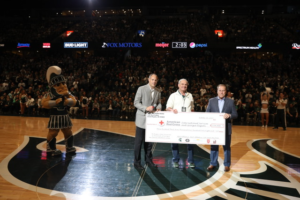Populous Promotes 16
Following its best-ever year of business, Populous has appointed more than a dozen staff members to Principal and Senior Principal status and added Senior Principal Bruce Miller to its global Holdings Board. An accomplished leader of Populous, Miller has led numerous successful baseball and professional soccer projects since joining the firm in 1989, including Target Field and Orlando City Stadium.
Miller is often cited as an expert source on stadium design for media including Sports Business Journal, Urban Land Magazine, National Public Radio, Design Intelligence, The Business of Sports, and Athletic Business. He has been guest lecturer at NYU and has spoken to industry leaders at the Freitas Seminar during the Winter Baseball Meetings. He was named a Sports Business Journal 40 Under 40 winner in 2003.
Promotions to Senior Principal:
Bob Gillcrist, Kansas City
Shireen Hamdan, London
Jonathan Mallie, New York
Brian Mirakian, Kansas City
Sherri Privitera, Kansas City
Promotions to Principal:
Brad Albers, Kansas City
Marc Bertolino, Kansas City
Steve Boyd, Kansas City
Steve Caudle, Kansas City
Tiric Chang, Beijing
Rhys Courtney, London
Jeanette Johnson, Denver
Marc Klein, Denver
Whitney Williams, Kansas City
“It is an exciting time for Populous – we are very much looking forward to the future. The promotion of these gifted individuals around the world signals a bright future for us,” said Earl Santee, Managing Director of Populous Americas.
Populous experienced a 15 percent increase in staffing for 2017, and expects to grow by another 15 percent through 2018.
Luther Burbank Center For The Arts Re-opens With November 9 Show
When Marc Hagenlocher, director of operations and events of the Luther Burbank Center for the Arts in Santa Rosa, California, toured with the venue’s insurance carrier and broker in the wake of sustained damage from the Tubbs Fire that spread throughout Northern California, he heard a refrain that the facility would not open until 2018.
Tsk, tsk. Never underestimate the resolve of those in the public assembly venue industry who want to work as quickly as possible to be a salve to their hurting community.
“That was not going to be acceptable to us,” Hagenlocher said. “Aside from the east end of our building and the East Auditorium, I don’t know  the lowdown on all the damage we sustained. A separate 3,000-square-foot facility is a total loss. Our sculpture garden and sculpture walk which is an outdoor large scale exhibit is about one-third completely totaled, one-third damaged, and one-third unscathed. When you look at what’s around us, this facility shouldn’t be standing. It’s just mind-blowing. Still, we knew we were going to be open and ready to deliver.
the lowdown on all the damage we sustained. A separate 3,000-square-foot facility is a total loss. Our sculpture garden and sculpture walk which is an outdoor large scale exhibit is about one-third completely totaled, one-third damaged, and one-third unscathed. When you look at what’s around us, this facility shouldn’t be standing. It’s just mind-blowing. Still, we knew we were going to be open and ready to deliver.
“The community is looking to us as a place for healing and a sense of normalcy. We are absolutely committed and driving to get this place stabilized, get it presentable, and get our doors open.”
While the facility was open on November 6 for limited use, the curtain went up in earnest on November 9 with a Shopkins Live! Shop It Up! performance that evening. A concert by the group Air Supply will follow on November 11.
Indeed, the Burbank Center has come a long way in a relatively short period of time.
“I live about a mile or so from the center in a development that was one of the affected communities,” said Rick Nowlin, president and CEO of the venue. “The fires started around here somewhere late in the evening about 9 pm on October 8 and then a lot of evacuations began taking place the next morning, which was a Monday.
“The fire started in the evening and thankfully nothing was going on at the center. The first responders were able to put it out. Marc and I were talking by 4 that morning about the fire and just where everything stood.”
Nowlin said that of the 140,000 square feet some 40,000 square feet was seriously impacted, most notably an educational building that called the Anova Center for Education that is a school for some 130 autistic children. That building was destroyed and the students are now in temporary facilities scattered about the Greater Santa Rosa and Windsor area.
“Our auditorium is also a total loss,” Hagenlocher said. “We have three theaters, including the 1,600-seat Ruth Finley Person Theater where we do most of our programming, the Carson Cabaret with about 200 in an open floor configuration, and the East Auditorium of 400 seats that is a total loss.”
Hagenlocher has spent most of the past month at the facility meeting with city officials, the Army Corp of Engineers, and others as they scrambled to get the venue back in an operating mode.
“The scale of this really is unprecedented in California,” Hagenlocher said. “It’s the biggest wildfire ever with six digits of square acres. Everyone is directly affected or has an employer or friend or family. We lost five percent of the Santa Rosa housing stock. In a city of 170,000-something people, to actually lose five percent of the housing stock is devastating.”
Hagenlocher noted without a hint of exaggeration that the fires that impacted the venue will become a case study for what can happen.
“Every year we get the emergency responders to come out,” he said. “Being a facility like ours, our event staff is quite used to call 911 for various things for all sorts of emergencies that happen on the property. We invite our first responders, whether it’s the sheriff’s department or the fire department, to talk with our staff about the what-ifs. I will tell you that never in any of those talks did they ever imagine this being a what-if. It was almost always like, if you have a fire within the facility, what do you do to get people out? When do you decide to evacuate?
“Sometimes that comes with its own risks being a big enough facility that we might have a fire alarm on the far end when does that evacuation get triggered? Those are some shades of grey in learning to have staff start thinking about those things. What happens often is things go on autopilot and the staff knows what to do even though it’s not clear cut where you check one box or another. It’s various shades of grey, but they never would have told you … about something so far beyond the wilderness area that comes into town and has this kind of reach. None of them.”
Nowlin expressed thanks to his colleagues in the industry who have contacted him by email and other means asking if there was anything they could do to help. “Our entire team led by Marc has been just incredible in working with local authorities to get the organization moving forward and back on track,” he said.
A Gofundme page has been established on the venue’s website. Nowlin said that it has not been pushed a lot and has not been actively promoted, but it does exist. He noted that during the past month the venue has been able to accept mail and make daily deposits although most of the staff has been working offsite from home or in temporary housing for those evacuated from their residences.
To contribute, please click here.
A Warm Welcome to Our Newest Members

Please welcome our newest members who joined IAVM in October 2017. Thank you for being a part of the association!
Also, let us get to know you better by participating in the I Am Venue Management series. Please visit http://www.iavm.org/i-am-venue-management-share-your-story to share your story and photo.
Michigan State-Georgia Charity Basketball Game Raises More Than $330K For Disaster Relief
Before Michigan State University and the University of Georgia played a recent exhibition basketball game at the SMG-managed Van Andel Arena in Grand Rapids, Michigan, a check for $339,448.90 was presented to representatives from the American Red Cross. The game became a sudden and last-minute addition to the schedule with the intent of raising funds to support disaster relief efforts.
Proceeds from the game will be collectively donated by both the universities and SMG/Van Andel Arena to the American Red Cross, with the funds being split equally  between Georgia’s designated Red Cross – Georgia Region and Michigan State’s designated Red Cross – International Services. After tickets sold out almost immediately, SMG, MSU, and Georgia staff received confirmation that the event would be a worthwhile endeavor.
between Georgia’s designated Red Cross – Georgia Region and Michigan State’s designated Red Cross – International Services. After tickets sold out almost immediately, SMG, MSU, and Georgia staff received confirmation that the event would be a worthwhile endeavor.
“We had confidence that the West Michigan community would respond to this event in a big way, and they certainly lived up to the expectations,” said SMG Regional General Manager Richard MacKeigan. “It had to come together very quickly, but the quality of the event paired with a great cause made this something we really wanted to be a part of.”
“We know West Michigan loves their Spartans, and we were certain that this community would jump at a chance to support communities recovering from recent disasters,” added Grand Rapids-Kent County Convention/Arena Authority Chairman and MSU alumnus Steve Heacock. “It’s a gratifying feeling to see the success today.”
With news of the possible event breaking on Monday, October 23, it left only six days to bring together what typically takes months to achieve. “I can’t say enough about the staff on all sides for making sure this event happened in such a short span,” MacKeigan said.
Organizers had to plan everything in a very limited time frame, including securing a basketball court for the game and having it arrive in Grand Rapids on time. Michigan State volunteered to bring their floor for the game, and without the necessary transportation to have it delivered, Meijer stepped in to donate semi-trucks and cover expenses to haul the court west to Van Andel Arena.
Both teams pledged to cover their own transportation and operational costs as well in order to achieve a maximum donation total possible from the event.
Steve Romer Joins Bluesfest As Chief Operating Officer
Steve Romer has been named as chief operating officer for Byron Bay Bluesfest, Australia’s premier contemporary blues and roots music festival. Bluesfest showcases music from around the world annually on the Easter-long weekend on 120 hectares at Tyagarah Tea Tree Farm, just north of Byron Bay, NSW. Bluesfest presents more than 200 performances with various stages over five 12-hour days, as well as camping for up to 6,000 people, five licensed bars, more than 100 food and market stalls, undercover food courts, beer gardens, and children’s entertainment.
From a modest crowd of 6,000 when it began in 1990, Bluesfest now attracts an audience of more than 100,000 and is regarded as the foremost destination festival in  Australia and renowned for being a safe, fun, family-friendly event.
Australia and renowned for being a safe, fun, family-friendly event.
Romer holds the same role for associated companies including Bluesfest Touring.
Romer has worked in the live music, sport and entertainment industries for 30 years and was most recently the past Chair and CEO of the Venue Management Association (Asia Pacific). He has held a wide variety of senior management roles including stints at the Sydney Entertainment Centre, Sydney Convention & Exhibition Centre, Sydney 2000 Olympics Satellite Stadiums, and with amusement park operators Macquarie Leisure Trust (now Ardent Leisure) and Village Roadshow Theme Parks.
“I am excited to be joining the team at the iconic Bluesfest Byron Bay, and look forward to working closely with Festival Director Peter Noble,” Romer said.
“We are proud to make the announcement that Steve is joining the Bluesfest group of companies, and will be overseeing operations across the annual festival in Byron Bay, Bluesfest Touring and the company’s land holdings,” Noble added. “Bluesfest has become a major player and I believe the recent additions to our dynamic team of Steve and Simone Twiss as chief financial officer will allow us to continue confidently into the future. I am also announcing that I am moving to the position of executive chairman and will continue to focus on booking talent as well as acquisitions that will take Bluesfest into an exciting new era.”
Romer officially begins in his new position on November 13
Do you want to receive a Front Row News weekly digest?
Categories
- Allied (861)
- Architecture (147)
- Arenas (750)
- Career (897)
- Convention Centers (897)
- Education (623)
- Events (1,544)
- Food & Beverage (193)
- Foundation (113)
- Guest Experience (1,497)
- Industry News (2,270)
- Leadership (1,888)
- Marketing (150)
- Membership (2,001)
- Music (213)
- Performing Arts Centers (456)
- Professional Development (409)
- Research (128)
- Safety & Security (442)
- Sports (764)
- Stadiums (611)
- Student (159)
- Technology (516)
- Ticketing (92)
- Touring (82)
- Trends (365)
- Uncategorized (697)
- Universities (218)
- Video (25)
- Young Professional (198)
Twitter Feed
- Twitter feed loading
Recent Posts
- Simpleview Welcomes Industry Veteran, Evelyn Ingram, to Newly Created Venue Digital Strategy Role
- ‘Another One’ for Nicholas Family of Companies: Firm to Break Ground on Elk Grove Ice Arena in Suburban Chicago
- Venue Sustainalytics Launches Website for First-Ever Sustainability Benchmarking Platform for Event Venues
- Maverik Center Names Jeff Davis, CVE, CVP, CMP, as New General Manager
- McAllen and Hidalgo Promoter Joe Vera III, CFEE, CECD, Among Those We Will Miss
Categories
- Allied
- Architecture
- Arenas
- Career
- Convention Centers
- Education
- Events
- Food & Beverage
- Foundation
- Guest Experience
- Industry News
- Leadership
- Marketing
- Membership
- Music
- Performing Arts Centers
- Professional Development
- Research
- Safety & Security
- Sports
- Stadiums
- Student
- Technology
- Ticketing
- Touring
- Trends
- Uncategorized
- Universities
- Video
- Young Professional
Archives
- August 2025
- July 2025
- June 2025
- May 2025
- April 2025
- March 2025
- February 2025
- January 2025
- December 2024
- November 2024
- October 2024
- September 2024
- August 2024
- July 2024
- June 2024
- May 2024
- April 2024
- March 2024
- February 2024
- January 2024
- December 2023
- November 2023
- October 2023
- September 2023
- August 2023
- July 2023
- June 2023
- May 2023
- April 2023
- March 2023
- February 2023
- January 2023
- December 2022
- November 2022
- October 2022
- September 2022
- August 2022
- July 2022
- June 2022
- May 2022
- April 2022
- March 2022
- February 2022
- January 2022
- December 2021
- November 2021
- October 2021
- September 2021
- August 2021
- July 2021
- June 2021
- May 2021
- April 2021
- March 2021
- February 2021
- January 2021
- December 2020
- November 2020
- October 2020
- September 2020
- August 2020
- July 2020
- June 2020
- May 2020
- April 2020
- March 2020
- February 2020
- January 2020
- December 2019
- November 2019
- October 2019
- September 2019
- August 2019
- July 2019
- June 2019
- May 2019
- April 2019
- March 2019
- February 2019
- January 2019
- December 2018
- November 2018
- October 2018
- September 2018
- August 2018
- July 2018
- June 2018
- May 2018
- April 2018
- March 2018
- February 2018
- January 2018
- December 2017
- November 2017
- October 2017
- September 2017
- August 2017
- July 2017
- June 2017
- May 2017
- April 2017
- March 2017
- February 2017
- January 2017
- December 2016
- November 2016
- October 2016
- September 2016
- August 2016
- July 2016
- June 2016
- May 2016
- April 2016
- March 2016
- February 2016
- January 2016
- December 2015
- November 2015
- October 2015
- September 2015
- August 2015
- July 2015
- June 2015
- May 2015
- April 2015
- March 2015
- February 2015
- January 2015
- December 2014
- November 2014
- October 2014
- September 2014
- August 2014
- July 2014
- June 2014
- May 2014
- April 2014
- March 2014
- February 2014
- January 2014
- December 2013
- November 2013
- October 2013
- September 2013
- August 2013
- July 2013
- June 2013
- May 2013
- April 2013
- March 2013
- February 2013
- January 2013
- May 2012
- March 2012
- December 2011
- November 2011
- October 2011
Recent Comments
- Frank Bradshaw, Ph.D., CVE on John Meyer, CVE, a Tireless Advocate of Certification for Venue Professionals, Has Died
- Neil Sulkes on Hilary Hartung, Friend to Many in Venue Marketing, Has Left Us
- Jason Parker, CVE on The Devastation of Hurricane Helene and How We Can Support One Another
- Larry Perkins on Touhey Testifies Against Speculative Ticketing Before Congressional Subcommittee
- Peter Secord on Major Players for Planned Elkhart Amphitheater Were in the Mix at VenueConnect
